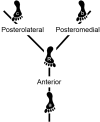MUSCULOSKELETAL SCREENING AND FUNCTIONAL TESTING: CONSIDERATIONS FOR BASKETBALL ATHLETES
- PMID: 27757291
- PMCID: PMC5046972
MUSCULOSKELETAL SCREENING AND FUNCTIONAL TESTING: CONSIDERATIONS FOR BASKETBALL ATHLETES
Abstract
Background and purpose: Youth participation in basketball is on the rise, with basketball one of the top five participation sports in Australia. With increased participation there is a need for greater awareness of the importance of the pre-participation examination, including musculoskeletal screening and functional performance testing as part of a multidisciplinary approach to reducing the risk for future injuries. As majority of all basketball injuries affect the lower extremities, pre-participation musculoskeletal screening and functional performance testing should assess fundamental movement qualities throughout the kinetic chain with an emphasis on lower extremity force characteristics, specifically eccentric loading tasks. Thus, the purpose of this clinical commentary is to review the existing literature elucidating pre-participation musculoskeletal screening and functional performance tests that can be used as a framework for rehabilitation professionals in assessing basketball athletes' readiness to safely perform the movement demands of their sport.
Methods: Relevant articles published between 2000 and 2016 using the search terms 'musculoskeletal screening', 'functional testing', 'youth athletes', and 'basketball' were identified using MEDLINE. From a basketball-specific perspective, several relevant musculoskeletal assessments were identified, including: the Functional Hop Test Combination, the Landing Error Scoring System, the Tuck Jump Assessment, the Weight-Bearing Lunge Test, and the Star Excursion Balance Test. Each of these assessments creates movement demands that allow for easy identification of inefficient and/or compensatory movement tendencies. A basic understanding of musculoskeletal deficits including bilateral strength and flexibility imbalances, lower crossed syndrome, and dominance-related factors are key components in determination of injury risk.
Discussion: Assessment of sport-specific movement demands through musculoskeletal screening and functional performance testing is essential for rehabilitation professionals to determine movement competency during performance of fundamental movements related to basketball performance. Youth athletes represent a unique population due to their developing musculoskeletal and neuromuscular systems and should undergo pre-participation musculoskeletal screening for identification of movement limitations. Such an approach to musculoskeletal screening and functional performance may assist in identifying injury risk and also be useful at the end of rehabilitation in determining readiness to return to sport models.
Level of evidence: Level 5.
Keywords: Basketball; injury prevention; musculoskeletal screening; youth athletes.
Figures





References
-
- International Basketball Federation. Quick facts. Available at: http://www.fiba.com. Accessed Feb 11 2013.
-
- Basketball Australia. Key facts: Update 2012. Sydney: Basketball Australia (BA) 2012.
-
- Hoffman J R. Epidemiology of basketball injuries. In: Douglas BM, ed. Handbook of Sports Medicine and Science: Basketball; 2008: 3-11.
-
- Stapff A. Protocols for the physiological assessment of basketball players. Physiological tests for elite athletes. Champaign: IL: Human Kinetics; 2000.
-
- Drinkwater EJ Pyne DB McKenna MJ. Design and interpretation of anthropometric and fitness testing of basketball players. Sports Med. 2008;38:565-578. - PubMed
LinkOut - more resources
Full Text Sources
Medical
Research Materials
